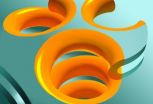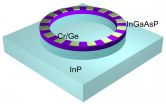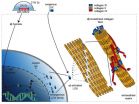INFORMATION:
The National Institutes of Health and the Mathematical Biosciences Institute of the National Science Foundation supported this work.
Link seen between seizures and migraines in the brain
2014-10-30
(Press-News.org) Seizures and migraines have always been considered separate physiological events in the brain, but now a team of engineers and neuroscientists looking at the brain from a physics viewpoint discovered a link between these and related phenomena.
Scientists believed these two brain events were separate phenomena because they outwardly affect people very differently. Seizures are marked by electrical hyperactivity, but migraine auras -- based on an underlying process called spreading depression -- are marked by a silencing of electrical activity in part of the brain. Also, seizures spread rapidly, while migraines propagate slowly.
"We wanted to make a more realistic model of what underlies migraines, which we were working on controlling," said Steven J. Schiff, Brush Chair Professor of Engineering and director of the Penn State Center for Neural Engineering. "We realized that no one had ever kept proper track of the neuronal energy being used and all of the ions, the charged atoms, going into and out of brain cells."
Potassium and sodium contribute the ions that control electricity in the brain. The Penn State researchers added fundamental physics principles of conservation of energy, charge and mass to an older theory of this electricity. They kept track of the energy required to run a nerve cell, and kept count of the ions passing into and out of the cells.
The brain needs a constant supply of oxygen to keep everything running because it has to keep pumping the ions back across cell membranes after each electrical spike. The energy supply is directly linked to oxygen concentrations around the cell and the energy required to restore the ions to their proper places is much greater after seizures or migraines.
"We know that some people get both seizures and migraines," said Schiff. "Certainly, the same brain cells produce these different events and we now have increasing numbers of examples of where single gene mutations can produce the presence of both seizure and migraines in the same patients and families. So, in retrospect, the link was obvious -- but we did not understand it."
The researchers, who also included Yina Wei, recent Penn State Ph.D. in engineering science and mechanics, currently a postdoctoral fellow at University of California-Riverside, and Ghanim Ullah, former Penn State postdoctoral fellow, now a professor of physics at University of South Florida, explored extending older models of brain cell activity with basic conservation principles. They were motivated by previous Penn State experiments that showed the very sensitive link between oxygen concentration with reliable and rapid changes in nerve cell behavior.
What they found was completely unexpected. Adding basic conservation principles to the older models immediately demonstrated that spikes, seizures and spreading depression were all part of a spectrum of nerve cell behavior. It appeared that decades of observations of different phenomena in the brain could share a common underlying link.
"We have found within a single model of the biophysics of neuronal membranes that we can account for a broad range of experimental observations, from spikes to seizures and spreading depression," the researchers report in a recent issue of the Journal of Neuroscience. "We are particularly struck by the apparent unification possible between the dynamics of seizures and spreading depression."
While the initial intent was to better model the biophysics of the brain, the connection and unification of seizures and spreading depression was an emergent property of that model, according to Schiff.
"No one, neither us nor our colleagues anticipated such a finding or we would have done this years ago," said Schiff. "But we immediately recognized what the results were showing and we worked intensively to test the integrity of this result in many ways and we found out how robust it was. Although the mathematics are complex, the linking of these phenomena seems rock solid."
The ability to better understand the difference between normal and pathological activity within the brain may lead to the ability to predict when a seizure might occur.
"We are not only interested in controlling seizures or migraines after they begin, but we are keen to seek ways to stabilize the brain in normal operating regimes and prevent such phenomena from occurring in the first place," said Schiff. "This type of unification framework demonstrates that we can now begin to have a much more fundamental understanding of how normal and pathological brain activities relate to each other. We and our colleagues have a lot on our plate to start exploring over the coming years as we build on this finding."
ELSE PRESS RELEASES FROM THIS DATE:
Researchers probe link between newborn health and vitamin A
2014-10-30
The impact vitamin A has on newborns is virtually unknown, but Penn State nutrition researchers have published two papers that may provide a framework for future investigations of the vitamin and neonatal health.
After supplementing newborn rats with vitamin A, the researchers found that vitamin A distribution within the body increases suddenly but temporarily, with a significant amount found in tissues other than the liver. Vitamin A in adults is usually found in significant amounts in the liver.
Nutrition experts know that vitamin A is necessary for prenatal growth ...
Could daylight saving time be a risk to diabetics?
2014-10-30
Soon, many will turn back the hands of time as part of the twice-annual ritual of daylight saving time. That means remembering to change the alarm clock next to the bed, which will mean an extra hour of sleep before getting up in the morning.
But for some diabetics who use insulin pumps, Saleh Aldasouqi, associate professor of medicine at Michigan State University, suggests that remembering to change the time on this device should be the priority.
"Some diabetes patients who use insulin pumps may forget to change the clock that is found in these devices," said diabetes ...
They know the drill: UW leads the league in boring through ice sheets
2014-10-30
MADISON, Wis. — Wisconsin is famous for its ice fishers — the stalwarts who drill holes through lake ice in the hope of catching a winter dinner. Less well known are the state's big-league ice drillers — specialists who design huge drills and use them to drill deep into ice in Greenland and Antarctica, places where even summer seems like winter.
The quarry at these drills includes some of the biggest catches in science.
A hot-water drill designed and built at the University of Wisconsin-Madison's Space Science and Engineering Center (SSEC) and the ...
New optimal screening threshold for gestational diabetes in twin pregnancies
2014-10-30
Philadelphia, PA, October 30, 2014 – A common complication, gestational diabetes affects approximately 6-7% of pregnant women. Currently, screening is done in two steps to help identify patients most at risk; however, the suggested levels for additional testing were based on singleton pregnancy data. Now investigators have analyzed data from twin pregnancies and have determined that the optimal first step cutoff for additional screening appears to be a blood sugar level equal to or greater than 135 mg/dL for women carrying twins. Their findings are published in the ...
For stroke patients, hospital bed position is delicate balancing act
2014-10-30
MAYWOOD, Ill. (Date) – During the first 24 hours after a stroke, attention to detail --such as hospital bed positioning -- is critical to patient outcomes.
Most strokes are caused by blood clots that block blood flow to the brain. Sitting upright can harm the patient because it decreases blood flow and oxygen to the brain just when the brain needs more blood.
Thus, it's reasonable to keep patients lying flat or as nearly flat as possible, according to a report in the journal MedLink Neurology by Loyola University Medical Center neurologist Murray Flaster, MD, ...
Biology meets geometry
2014-10-30
(Santa Barbara, Calif.) — Architecture imitates life, at least when it comes to those spiral ramps in multistory parking garages. Stacked and connecting parallel levels, the ramps are replications of helical structures found in a ubiquitous membrane structure in the cells of the body.
Dubbed Terasaki ramps after their discoverer, they reside in an organelle called the endoplasmic reticulum (ER), a network of membranes found throughout the cell and connected to and surrounding the cell nucleus. Now, a trio of scientists, including UC Santa Barbara biological physicist ...
Heart's own immune cells can help it heal
2014-10-30
The heart holds its own pool of immune cells capable of helping it heal after injury, according to new research in mice at Washington University School of Medicine in St. Louis.
Most of the time when the heart is injured, these beneficial immune cells are supplanted by immune cells from the bone marrow, which are spurred to converge in the heart and cause inflammation that leads to further damage. In both cases, these immune cells are called macrophages, whether they reside in the heart or arrive from the bone marrow. Although they share a name, where they originate appears ...
Study shows vibrating insoles could reduce falls among seniors
2014-10-30
BOSTON — Findings published in the Archives of Physical Medicine and Rehabilitation show that imperceptible vibratory stimulation applied to the soles of the feet improved balance by reducing postural sway and gait variability in elderly study participants. The vibratory stimulation is delivered by a urethane foam insole with embedded piezoelectric actuators, which generates the mechanical stimulation. The study was conducted by researchers from the Institute for Aging Research (IFAR) at Hebrew SeniorLife, Beth Israel Deaconess Medical Center, the Wyss Institute for ...
Lord of the microrings
2014-10-30
A significant breakthrough in laser technology has been reported by the U.S. Department of Energy (DOE)'s Lawrence Berkeley National Laboratory (Berkeley Lab) and the University of California (UC) Berkeley. Scientists led by Xiang Zhang, a physicist with joint appointments at Berkeley Lab and UC Berkeley, have developed a unique microring laser cavity that can produce single-mode lasing even from a conventional multi-mode laser cavity. This ability to provide single-mode lasing on demand holds ramifications for a wide range of applications including optical metrology and ...
Making lab-grown tissues stronger
2014-10-30
Lab-grown tissues could one day provide new treatments for injuries and damage to the joints, including articular cartilage, tendons and ligaments.
Cartilage, for example, is a hard material that caps the ends of bones and allows joints to work smoothly. UC Davis biomedical engineers, exploring ways to toughen up engineered cartilage and keep natural tissues strong outside the body, report new developments this week in the journal Proceedings of the National Academy of Sciences.
"The problem with engineered tissue is that the mechanical properties are far from those ...




